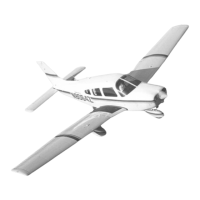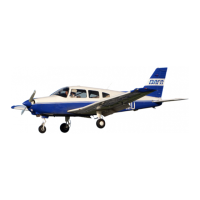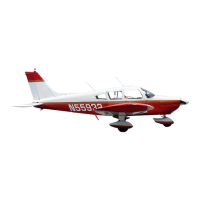PIPER AIRCRAFT, INC.
PA-28-161, WARRIOR III
MAINTENANCE MANUAL
PAGE 7
Nov 30/06
4J5
71-00-00
3. Static RPM
The maximum static rpm value for a fixed pitch propeller equipped aircraft provides an indication that the
engine/propeller combination is meeting rated power output.
Low static rpm indicates low engine power or incorrect propeller (higher pitch/longer diameter) while a
high rpm indicates high engine power or incorrect propeller diameter), any of which is not desirable. For
this reason it is important that each propeller combination meets the criteria of this section. However,
many factors influence engine power and therefore the actual static rpm can change significantly. This
section provides a procedure whereby accurate and repeatable static rpm values may be obtained.
A. Equipment
The following equipment is required to accomplish this ground test procedure:
(1) Vu-thru tachometer
(2) Means to obtain outside air temperature and relative humidity or dew point. The following
sources and methods may be used, but are not the only means.
(a) ATIS
(b) Calibrated Thermometer
(c) Calibrated Psychrometer
(d) National Weather Service
(e) Omega Hand Held Hygrometers, models RH-201 and RH-30 or equivalent.
B. Test Procedure
This section describes the ground test procedure for determining the maximum static rpm value for
the fixed pitched propeller Warrior III. A simplified test procedure is provided first to test static rpm
under limited conditions. In the event that the test conditions do not fall within the limits of Chart
710x, proceed to the expanded test procedure.
(1) Simplified Test Procedure
(a) Obtain ambient outside air temperature and dew point.
(b) Head aircraft into the wind.
(c) Apply full throttle. Avoid prolong runs at full power.
(d) Allow oil temperature to reach 180 ± 10 degrees.
(e) Record the test static rpm using the Vu-thru tachometer.
(f) Using the outside air temperature and dew point enter Chart 2 and read the
corresponding baseline rpm value. With baseline value and tested static rpm, proceed to
paragraph c, below.
NO
TE: Use the temperature and dew point values on the table which most closely
correspond to the test condition. Interpolate baseline rpm if temperature and/or
dew point fall equally between two or more blocks.
(2) Expanded Test Procedure
The worksheet found on the following page should be copied and the copy used to document
the following expanded test procedure.
(a) Obtain ambient outside air temperature and relative humidity.
NOTE: Relative humidity may be obtained using a psychrometric chart (Chart 5) if the
outside air temperature, and dew point, or wet bulb are known.
(b) Head aircraft into the wind.
(c) Apply full throttle. Avoid prolonged runs at full power.

